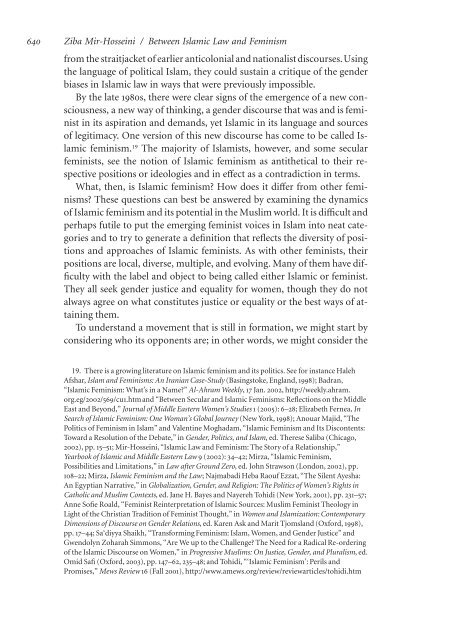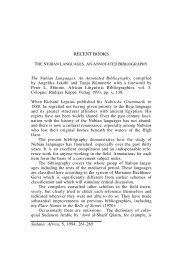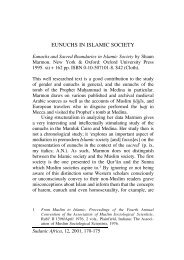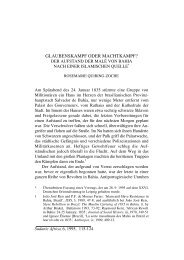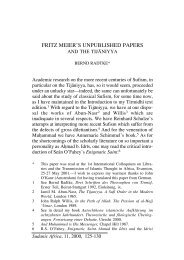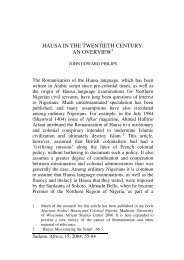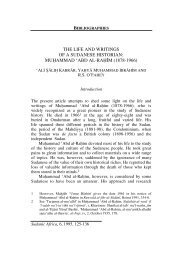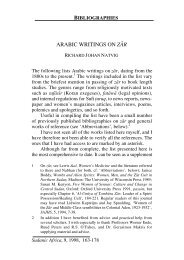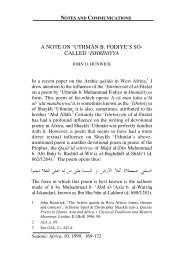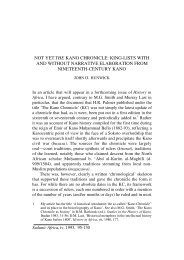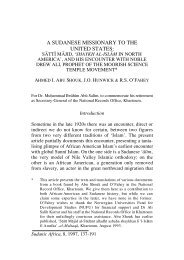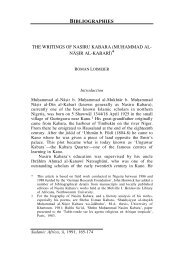Muslim Women's Quest for Equality: Between Islamic Law and ...
Muslim Women's Quest for Equality: Between Islamic Law and ...
Muslim Women's Quest for Equality: Between Islamic Law and ...
You also want an ePaper? Increase the reach of your titles
YUMPU automatically turns print PDFs into web optimized ePapers that Google loves.
640 Ziba Mir-Hosseini / <strong>Between</strong> <strong>Islamic</strong> <strong>Law</strong> <strong>and</strong> Feminismfrom the straitjacket of earlier anticolonial <strong>and</strong> nationalistdiscourses.Usingthe language of political Islam, they could sustain a critique of the genderbiases in <strong>Islamic</strong> law in ways that were previously impossible.By the late 1980s, there were clear signs of the emergence of a new consciousness,a new way of thinking, a gender discourse that was <strong>and</strong> is feministin its aspiration <strong>and</strong> dem<strong>and</strong>s, yet <strong>Islamic</strong> in its language <strong>and</strong> sourcesof legitimacy. One version of this new discourse has come to be called <strong>Islamic</strong>feminism. 19 The majority of Islamists, however, <strong>and</strong> some secularfeminists, see the notion of <strong>Islamic</strong> feminism as antithetical to their respectivepositions or ideologies <strong>and</strong> in effect as a contradiction in terms.What, then, is <strong>Islamic</strong> feminism? How does it differ from other feminisms?These questions can best be answered by examining the dynamicsof <strong>Islamic</strong> feminism <strong>and</strong> its potential in the <strong>Muslim</strong> world. It is difficult <strong>and</strong>perhaps futile to put the emerging feminist voices in Islam into neat categories<strong>and</strong> to try to generate a definition that reflects the diversity of positions<strong>and</strong> approaches of <strong>Islamic</strong> feminists. As with other feminists, theirpositions are local, diverse, multiple, <strong>and</strong> evolving. Many of them have difficultywith the label <strong>and</strong> object to being called either <strong>Islamic</strong> or feminist.They all seek gender justice <strong>and</strong> equality <strong>for</strong> women, though they do notalways agree on what constitutes justice or equality or the best ways of attainingthem.To underst<strong>and</strong> a movement that is still in <strong>for</strong>mation, we might start byconsidering who its opponents are; in other words, we might consider the19. There is a growing literature on <strong>Islamic</strong> feminism <strong>and</strong> its politics. See <strong>for</strong> instance HalehAfshar, Islam <strong>and</strong> Feminisms: An Iranian Case-Study (Basingstoke, Engl<strong>and</strong>, 1998); Badran,“<strong>Islamic</strong> Feminism: What’s in a Name?” Al-Ahram Weekly, 17 Jan. 2002, http://weekly.ahram.org.eg/2002/569/cu1.htm<strong>and</strong> “<strong>Between</strong> Secular <strong>and</strong> <strong>Islamic</strong> Feminisms: Reflections on the MiddleEast <strong>and</strong> Beyond,” Journal of Middle Eastern Women’s Studies 1 (2005): 6–28; Elizabeth Fernea, InSearch of <strong>Islamic</strong> Feminism: One Woman’s Global Journey (New York, 1998); Anouar Majid, “ThePolitics of Feminism in Islam” <strong>and</strong> Valentine Moghadam, “<strong>Islamic</strong> Feminism <strong>and</strong> Its Discontents:Toward a Resolution of the Debate,” in Gender, Politics, <strong>and</strong> Islam, ed. Therese Saliba (Chicago,2002), pp. 15–51; Mir-Hosseini, “<strong>Islamic</strong> <strong>Law</strong> <strong>and</strong> Feminism: The Story of a Relationship,”Yearbook of <strong>Islamic</strong> <strong>and</strong> Middle Eastern <strong>Law</strong> 9 (2002): 34–42; Mirza, “<strong>Islamic</strong> Feminism,Possibilities <strong>and</strong> Limitations,” in <strong>Law</strong> after Ground Zero, ed. John Strawson (London, 2002), pp.108–22; Mirza, <strong>Islamic</strong> Feminism <strong>and</strong> the <strong>Law</strong>; Najmabadi Heba Raouf Ezzat, “The Silent Ayesha:An Egyptian Narrative,” in Globalization, Gender, <strong>and</strong> Religion: The Politics of Women’s Rights inCatholic <strong>and</strong> <strong>Muslim</strong> Contexts, ed. Jane H. Bayes <strong>and</strong> Nayereh Tohidi (New York, 2001), pp. 231–57;Anne Sofie Roald, “Feminist Reinterpretation of <strong>Islamic</strong> Sources: <strong>Muslim</strong> Feminist Theology inLight of the Christian Tradition of Feminist Thought,” in Women <strong>and</strong> Islamization: ContemporaryDimensions of Discourse on Gender Relations, ed. Karen Ask <strong>and</strong> Marit Tjomsl<strong>and</strong> (Ox<strong>for</strong>d, 1998),pp. 17–44; Sa‘diyya Shaikh, “Trans<strong>for</strong>ming Feminism: Islam, Women, <strong>and</strong> Gender Justice” <strong>and</strong>Gwendolyn Zoharah Simmons, “Are We up to the Challenge? The Need <strong>for</strong> a Radical Re-orderingof the <strong>Islamic</strong> Discourse on Women,” in Progressive <strong>Muslim</strong>s: On Justice, Gender, <strong>and</strong> Pluralism, ed.Omid Safi (Ox<strong>for</strong>d, 2003), pp. 147–62, 235–48; <strong>and</strong> Tohidi, “‘<strong>Islamic</strong> Feminism’: Perils <strong>and</strong>Promises,” Mews Review 16 (Fall 2001), http://www.amews.org/review/reviewarticles/tohidi.htm


